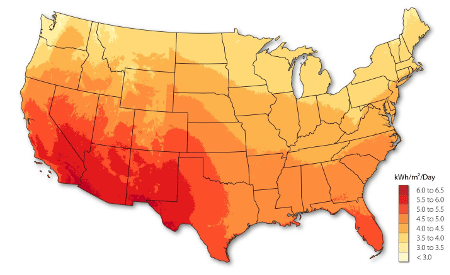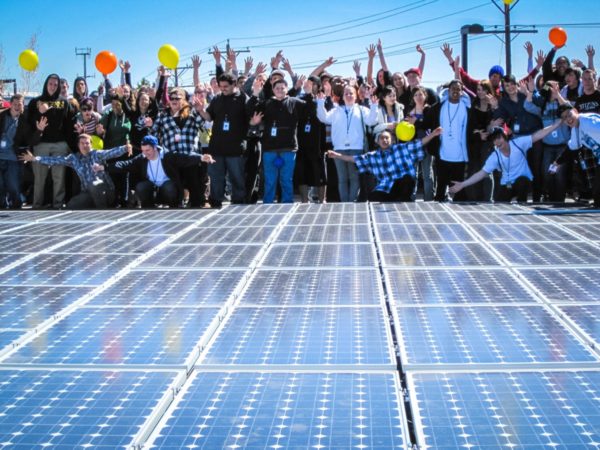Guess what folks, you’ve got to make some hard choices. They have to be adult choices, because the consequences are real.
Simply stated, if you want to save turtles, trees, and turnips in California – put your name down in support of Net Metering.
The choice is on how much solar you want on large solar farms in the desert, or on farmed flat land, and how much solar power you want to build on top of commercial buildings, homes, and parking lots.
Since you want to live in an energy dependent society, we have to generate clean energy for our homes and transportation.
 How do we clean these things? Well, we all could ride bikes, but Californians love cars. We could all move to temperate climates where we don’t need air conditioning, but much of California’s population lives in a desert.
How do we clean these things? Well, we all could ride bikes, but Californians love cars. We could all move to temperate climates where we don’t need air conditioning, but much of California’s population lives in a desert.
We’ve chosen an energy dependent lifestyle, we’ve chosen suburbia, and we’ve decided to move beyond nuclear generated electricity. We want that cake and, dammit, we’re gonna try to eat it too.
So, let’s lay the choices out in front of us.
California electricity utilities are attempting to cut the value we pay locally generated solar electricity. However, we need net metering to fully recognize the value of solar power on our homes and businesses if those rationally minded folks are going to invest.
What can rooftop solar do for us?
According to the U.S. Department of Energy’s National Renewable Energy Laboratory (NREL), rooftop solar alone – using modern 20% efficient solar panels – has the potential to meet almost 90% of California’s electricity needs as of 2020. You can up that to roughly 100% if we covered our roofs in 22% efficient solar panels.
Recognizing this, the State of California recently passed legislation requiring that all new homes include solar panels, and that’s an amazing start. However, if we’re going to fight climate change, we cannot wait for the state to rebuild all of its buildings.

Image: Wikipedia/Frank Schulenberg
What about when the power lines are shut down? Investor-owned utility Pacific Gas & Electric incompetently managed powerline maintenance which led to hundreds of deaths due to forest fires. Now, to manage this risk, the utility’s solution is to intermittently shut down power lines during fire season.
To combat utilities shutting down the power grid, a southern California water treatment district is consulting with this author to build two solar power plus energy storage facilities to keep the water running during these fire events. The group has recently signed on for a $25 million facility upgrade.
The state knows this isn’t how we should be living our lives, that’s why they put money up for energy storage. If we believe energy storage is important in these fire hurt regions, why take away money for the electricity source for those batteries?
What can rooftop solar save us?
In terms of the power lines that catch the forests on fire, we need billions of dollars fewer of them when we install more local rooftop solar. This is because bigger power lines are needed to bring electricity from the desert to where we live. Building those lines costs money, money that local solar saves us.
In addition to power lines, one research group found that by 2030 alone, distributed solar and energy storage could save electricity customers $109 billion since private people are investing their own money into upgrading the power grid.

Image: NREL
It seems distributed solar makes more money for people when it gets built, and saves money for people by lowering grid upgrade costs. Not to mention, it’s home and local business owners who save money on their electricity bills from solar.
It starts to make sense though that the centralized power company – which makes guaranteed money by having a big centrally managed power grid – might fight back against a network of home and business owners who tie their power plants together.
What does rooftop solar cost us?
The increase in costs between rooftop solar and desert solar is mostly salesperson commissions, paperwork, and hourly wages for electricians and mechanical system installers. After all, it takes a lot of time to move residential solar power projects through the sales, permitting, interconnection, procurement, and construction process.

Image: Wikimedia Commons/Dave Dougdale
Some will point directly to the low cost of electricity contracts signed by large-scale solar power to suggest that is why it’s cheaper. However, no homeowner gets to buy electricity for a few pennies per kilowatt hour. The homeowner has to pay the guaranteed 10% profit margin for the utility, not to mention paying the cost for the thousands of miles of power lines. And, the homeowner has to pay the power company to cut down trees around its transmission rights of way to reduce fire danger.
This author wonders whether spending more money on human beings to install solar power is really such a bad thing? Is it really a bad thing that our neighbors are getting paid a little bit more to help build our planet’s clean energy revolution?
Research in Maryland suggests that the monies paid to local electricians, engineers, warehouse workers, installers, shop people, drivers, was worth more than then electricity cost.
Class warfare?
Those who control the decision making at centralized utilities have decided that class warfare is the best way to attack your neighbors. The standard line of attack against net metering is that it increases the prices of electricity for everyone else.

Medium.com
In California, the utilities tell the state that solar power is for rich white people.
First, this is absolutely a lie. The largest chunk of solar owners are in no sense rich – they’re people whose household incomes range from $50,000 to 100,000 a year.
They are YOU.
Second, the wealthy attacking homeowners is part and parcel of class warfare. Why get mad at the fat cat who doesn’t drive their own car, when we can get mad at Joe and Susan down the street who drive a nicer car than me?
Remember, these are the same companies who lied to you about climate change and have known about its reality since the 1960s.
If you want to push back against those who care more about their guaranteed public approved monopoly return on investment, put your name down in support of California Net Metering.
The views and opinions expressed in this article are the author’s own, and do not necessarily reflect those held by pv magazine.
This content is protected by copyright and may not be reused. If you want to cooperate with us and would like to reuse some of our content, please contact: editors@pv-magazine.com.








Lawrence Berkeley National Laboratory listed the median income of solar households at $113,000 in a report from earlier this year. The median US household income is $69,000. You can do a lot with an extra $44,000 a year. You could, for example, easily install a solar system without asking for the households that make $69,000 to help you pay for it.
https://eta-publications.lbl.gov/sites/default/files/solar-adopter_income_trends_final.pdf
Here’s an idea for all of you NEM fans. Put your money where your mouths are. Fill your roofs with solar and shove a shed full of batteries next to the heated pool out back. Hmmm… You’ll also want a diesel backup generator. Say bye bye to the evil grid electricity and manage your own supply of power. We’ll miss all 14 of you. Enjoy having a much higher carbon footprint than the grid.
That’s interesting about NREL’s estimate of rooftop solar potential. I wonder what happens when we electrify heating and transportation. Hmmm… What about the 3000 TWh of process heat we use every year? Should we build more urban sprawl so we can install more rooftop solar?
Isn’t it ironic how urban sprawl is an enabler of rooftop solar?
“The state knows this isn’t how we should be living our lives, that’s why they put money up for energy storage. If we believe energy storage is important in these fire hurt regions, why take away money for the electricity source for those batteries?”
This is a non-sequitur. We can and should restructure tariffs such that there’s a clear incentive for storage. The best way to do this is to raise fixed charges up to about $70 a month and reduce the unit costs of electricity down to 1 to 5 cent/kWh. If you fluctuate the electricity price you create an incentive for arbitrage. There isn’t a whole lot of money on the table but there’s enough to encourage people to move around when they charge their EV sand water heaters.
You’re going out of your way to make it look like IOUs are the only ones who don’t like NEM. This simply isn’t true. Utility scale solar and wind interests don’t like NEM. Rate payer advocacy groups like TURN, ORA and CARE don’t like NEM. Environmental groups like the NRDC and the Sierra Club have come out against NEM. A lot of us don’t like NEM because it simply isn’t a sustainable way to scale solar.
Is the author in favor of the NEM 3.0 proposal? It seems disenfranchise the rooftop solar owners by charging a peanut tax of $8/kw generation per month and reduce the credit to $0.04 per KWH generated. This is ludicrous. Comments please!
Hello, here is an opposing view from our publication: https://pv-magazine-usa.com/2021/12/23/nem-3-0-erodes-solar-value-makes-batteries-essential-and-weakens-grid-flexibility-in-california/
I don’t think the fees make sense. Those seem to kill things.